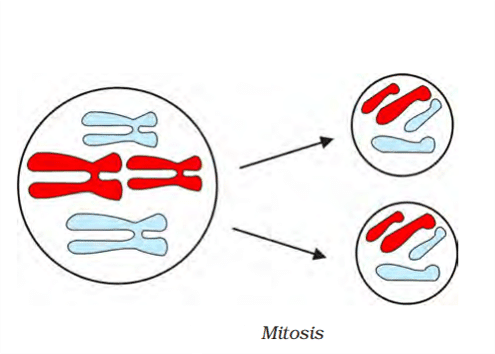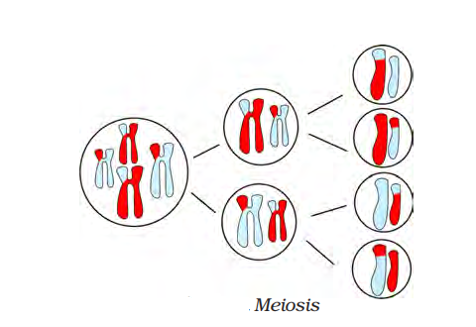The Fundamental Unit of Life Important Questions for Class 9
Hello everyone, this post contains all the important questions from Chapter - The Fundamental Unit of Life Class 9 Science. All these important questions are hand-picked by CBSE Guidance. Must prepare these questions to score maximum in your exams.
Q. No. 1) Define Plasmolysis.
Ans. It is the shrinkage of cytoplasm due to loss of water when kept in a hypertonic solution.
Q. No. 2) Where are genes located?
Ans. Genes are located on chromosomes in the nucleus.
Q. No. 3) What is a plasma membrane made up of?
Ans. The plasma membrane is made up of proteins and lipids.
Q. No. 4) What is osmosis?
Ans. The movement of water molecules through a selectively permeable membrane is called osmosis. This takes place from higher water concentration to lower water concentration.
Q. No. 5) “Osmosis is a special kind of diffusion.” Comment.
Ans. Yes, it is true. In both phenomena, there is the movement of particles from a region of higher concentration to that of lower concentration. However, in the case of osmosis, the movement of the solvent is through a semi-permeable membrane which is permeable only to water molecules.
Q. No. 6) Why do mitochondria have largely folded inner membranes?
Ans. Mitochondria have a largely folded inner membrane which provides the increased surface area for ATP-generating chemical reactions.
Q. No. 7) Damini’s mother wanted to make Mango pickles. She asked Damini to cut the tender mango into four and smear it with common salt and keep it for some time. She did so and observed that after some time the mango pieces had started to lose water and they have shrunken in size. Name the phenomenon observed by Damini.
Ans. Exosmosis.
Q. No. 8) Name the cell organelles that have their own DNA and ribosomes. Name the autonomous organelles in the cell.
Ans. Mitochondria and Plastids.
Also see: Class 9 Science Important Questions
Q. No. 9) Name the cell organelle due to which leaves, flowers, and fruits get their color.
Ans. Chromoplast.
Q. No. 10) Why is plasma membrane called selectively permeable membrane?
Ans. A plasma membrane allows the entry and exit of some materials in and out of the cell. It also prevents the movement of some other materials. So, it is called a selectively permeable membrane.
Q. No. 11) How do substances like CO2 and water move in and out of the cell?
Ans. The substances like CO2 move in and out of a cell by diffusion from the region of high concentration to low concentration. Water also obeys the law of diffusion. The movement of water molecules through such a selectively permeable membrane is called osmosis.
Q. No. 12) What are chromosomes? What are they made of?
Ans. The compact rod-like bodies inside the nucleus are called chromosomes. These are seen at the time of cell division. They are made up of DNA (deoxyribonucleic acid) and proteins.
Q. No. 13) Cells of onion peel and RBC are separately kept in a hypotonic solution, what among the following will take place? Explain the reason for your answer.
a) Both the cells will swell.
b) RBC will burst easily while cells of onion peel will resist the bursting to some extent.
c) a and b both are correct
d) RBC and onion peel cells will behave similarly.
Ans. Option (b); Because onion peel has a cell wall and RBC does not have a cell wall. The onion peels cell swells, building up pressure against the cell wall. The wall exerts equal pressure against the swollen cell.
Q. No. 14) Differentiate between diffusion and osmosis.
Ans.
| Osmosis | Diffusion |
| 1. It involves the movement of solvent molecules. | 1. It involves the movement of solute molecules. |
| 2. Molecules move from a lower concentration of solute to a higher concentration of solute. | 2. Molecules move from a higher concentration of solute to a lower concentration of solute. |
| 3. It occurs only across a semi-permeable membrane. | 3. It does not require a semi-permeable membrane. |
| 4. Example: Shrinking of Potato slice when kept in concentrated sucrose solution. | 4. Example: Spreading of ink when a drop of it is put in a glass of water. |
Q. No. 15) Differentiate between Rough Endoplasmic Reticulum and Smooth Endoplasmic Reticulum. How is Endoplasmic Reticulum important for membrane biogenesis?
Ans.
| Rough Endoplasmic Reticulum (RER) | Smooth Endoplasmic Reticulum (SER) |
| 1. RER has particles of the ribosome on the surface. | 1. SER has no ribosomal particles on the surface. |
| 2. Ribosomes are the sites of protein synthesis. | 2. SER helps in the manufacture of lipids and fats molecules. |
The rough endoplasmic reticulum (RER) and smooth endoplasmic reticulum (SER) help in the manufacture of proteins and lipids. Some of these proteins and lipids help in building the cell membrane. This process is known as membrane biogenesis.
Q. No. 16) Distinguish between hypotonic solution, isotonic solution, and hypertonic solution.
Ans.
| Hypotonic Solution | Isotonic Solution | Hypertonic Solution |
| 1. External solution having a higher concentration of water than the cell cytoplasm is known as a hypotonic solution. | 1. External solution having exactly the same concentration of water as that of cell cytoplasm is called an isotonic solution. | 1. External solution having a lower concentration of water than a cell cytoplasm is called a hypertonic solution. |
| 2. Cell swells up in this solution. | 2. Cell size remains the same. | 2. Cell shrinks in this solution. |
Q. No. 17) If a person takes the concentrated solution of salt after some time, he starts vomiting. What is the phenomenon responsible for such a situation? Explain.
Ans. A concentrated salt solution is a hypertonic solution, therefore it causes exosmosis. The outward movement of water from the cell results in irritation and excessive dehydration. This causes vomiting.
Q. No. 18) How is a bacterial cell different from an onion cell?
Ans.
| Bacterial Cell | Onion Cell |
| 1. It is a prokaryotic cell. | 1. It is a Eukaryotic cell. |
| 2. Size: generally small. | 2. Size: generally large. |
| 3. Nuclear region: poorly defined due to the absence of a nuclear membrane. Such an undefined nuclear region containing only nucleic acids is called a nucleoid. | 3. Nuclear region: well defined and surrounded by a nuclear membrane. |
| 4. Chromosome: single. | 4. More than one chromosome. |
| 5. Membrane-bound cell organelles absent. | 5. Membrane-bound cell organelles present. |
Q. No. 19) Name the organelles which show the analogy written as under:
a. Transporting channels of the cell
b. The powerhouse of cell
c. Packaging and dispatching unit of the cell
d. Digestive bag of the cell
e. Storage sacs of the cell
f. Kitchen of the cell
g. Control room of the cell
Ans.
a. Endoplasmic Reticulum
b. Mitochondria
c. Golgi apparatus
d. Lysosomes
e. Vacuoles
f. Chloroplast
g. Nucleus
Q. No. 20) Why are lysosomes known as suicidal bags of a cell?
Ans. Lysosomes are known as suicide bags because when the cell gets damaged during a disturbance in cellular metabolism, lysosomes may burst and the digestive enzymes thus released digest their own cell.
Q. No. 21) Illustrate only a plant cell as seen under an electron microscope. How is it different from an animal cell?
Ans.

| Plant Cell | Animal Cell |
| 1. Cell wall present | 1. Cell wall absent |
| 2. Plastids are present | 2. Plastids are absent |
| 3. It has a large vacuole | 3. It has a small vacuole |
| 4. Centriole absent | 4. Centriole present |
Q. No. 22) Draw a neat labeled diagram of an animal cell.
Ans.

Q. No. 23) Which type of cell division is required for the growth and repair of the body and which type is involved in the formation of gametes?
Ans. For growth and repair of the body: Mitosis
For gametes formation: Meiosis
Q. No. 24) Differentiate between Mitosis and Meiosis.
Ans.
| Mitosis | Meiosis |
| 1. This is required for the growth and repair of the body. | 1. This is involved in the formation of gametes. |
| 2. Two identical daughter cells are produced. | 2. Four new cells are formed. |
| 3. The daughter cells have the same number of chromosomes as the mother cell. | 3. The new cells have half the number of chromosomes as that of the mother cells. |
| 4. Completed in one stage. | 4. Completed in two stages. |
5.  | 5.  |
Awesome notes